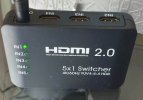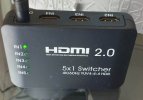The aura has two storage devices, 8.4 GB Internal shared storage, and 0.98 TB Internal HDD ( 1 TB Version).I don't get it. Having two mass-storage units increases the cost, and the "OS" might well not be on the spinny disk anyway (it's not in an Android phone or tablet, or in any previous Humax PVR).
-
 The forum software that supports hummy.tv has been upgraded to XenForo 2.3!
The forum software that supports hummy.tv has been upgraded to XenForo 2.3!
Please bear with us as we continue to tweak things, and feel free to post any questions, issues or suggestions in the upgrade thread.
You are using an out of date browser. It may not display this or other websites correctly.
You should upgrade or use an alternative browser.
You should upgrade or use an alternative browser.
Aura UHD android TV recorder November launch
- Thread starter Luke
- Start date
D
Deleted member 473
So Humax may have set off production cost to the detriment of running cost. I can't understand why else the HDD should be spinning at odd times. There is an option of how often the unit wakes up to check if there are remote recordings, but that could be handled without the HDD spinning, too. There is no explanation of whether this is to do with shallow or deep standby. In shallow standby, it is awake all the time, anyway, but is the frequency of checking to do with how often it connects to the internet, rather than how often it "wakes up?"I don't get it. Having two mass-storage units increases the cost, and the "OS" might well not be on the spinny disk anyway (it's not in an Android phone or tablet, or in any previous Humax PVR).
Having said all this, mobiles generally take forever to wake from being off. Both Android and iOS. The only mobile I have that goes quickly from off to responsive is a Windoze tablet, a Surface Go. That boots as fast as a modern laptop does.
D
Deleted member 473
| Flash | eMMC 16GB |
|---|---|
| RAM | LPDDR4 3GB |
| HDD | 1TB/2TB |
Black Hole
May contain traces of nut
...which won't be in the form of an SSD, any more that a phone is fitted with an SSD. When I said "mass-storage device", I'm sure you know I didn't mean motherboard Flash.8.4 GB Internal shared storage
grahamlthompson
Well-Known Member
OK, but if there is a recording, the HDD can wake up 15 minutes before, why is it running hours before?
It shoudn't be. It normally shuts down about 10 - 15 minutes after a recording finishes unless there are others scheduled shortly.
MartinOnline
Member
GLT,
I shutdown my 1 TB Aura using the long remote power push at 2110 last night and left the Aura HDMI cable connected to the HDMI switch which had its input green LED lit. No other inputs were connected to the switch and nor was the TV HDMI cable.
At 0800 this morning I checked the set up and the green LED was still lit indicating power from the Aura.
I re-attached the HDMI cable to the TV and started the Aura.
The timing results to the HUMAX splash screen and to the Android Animation but the time to the Live TV was~17s longer.
As far as I can see there are no additional power-control settings available to further shutdown the Aura from the long-push remote control option.
Unless you know of other power-control settings the cause of the timing differences remain a mystery, though, of course, my Aura may well be defective and fails to properly go into deep-standby mode.
I shutdown my 1 TB Aura using the long remote power push at 2110 last night and left the Aura HDMI cable connected to the HDMI switch which had its input green LED lit. No other inputs were connected to the switch and nor was the TV HDMI cable.
At 0800 this morning I checked the set up and the green LED was still lit indicating power from the Aura.
I re-attached the HDMI cable to the TV and started the Aura.
The timing results to the HUMAX splash screen and to the Android Animation but the time to the Live TV was~17s longer.
As far as I can see there are no additional power-control settings available to further shutdown the Aura from the long-push remote control option.
Unless you know of other power-control settings the cause of the timing differences remain a mystery, though, of course, my Aura may well be defective and fails to properly go into deep-standby mode.
grahamlthompson
Well-Known Member
And, as I said before, keeping the OS on a small SSD solves both the longevity and power saving problems. Stick the recordings on a separate drive, that shuts down when not in use.
The box only has one sata drive port. What are you going to connect it to ?
grahamlthompson
Well-Known Member
GLT,
I shutdown my 1 TB Aura using the long remote power push at 2110 last night and left the Aura HDMI cable connected to the HDMI switch which had its input green LED lit. No other inputs were connected to the switch and nor was the TV HDMI cable.
At 0800 this morning I checked the set up and the green LED was still lit indicating power from the Aura.
I re-attached the HDMI cable to the TV and started the Aura.
The timing results to the HUMAX splash screen and to the Android Animation but the time to the Live TV was~17s longer.
As far as I can see there are no additional power-control settings available to further shutdown the Aura from the long-push remote control option.
Unless you know of other power-control settings the cause of the timing differences remain a mystery, though, of course, my Aura may well be defective and fails to properly go into deep-standby mode.
You should be monitoring one of the USB ports. No idea if the HDMI port has power in full sby. It wouldn't have any output of course even in active sby.
Something like this
Here what I use, The power connection has a usb plug on the other end. There are no HDMI cables attached.
Attachments
Last edited:
D
Deleted member 473
That is a Humax design decision. Perhaps they should have designed it with two ports. Nothing we can do with it now, after Humax made a bad choice.The box only has one sata drive port. What are you going to connect it to ?
MymsMan
Ad detector
The disk is running to maintain the TSR buffer allowing you to rewind live TV.So Humax may have set off production cost to the detriment of running cost. I can't understand why else the HDD should be spinning at odd times.
Arguably they could have monitored the state of the HDMI connection and only activated TSR when there is a TV switched on but at the time the first PVRs were developed they also had to support SCART connections and I don't know if they allowed sensing of the the remote state. In any event it would have added extra complexity to the design.
You can argue as long as you like about how Humax could/should have implemented something but it is all irrelevant - you have to live with how they did choose to implement it.
grahamlthompson
Well-Known Member
That is a Humax design decision. Perhaps they should have designed it with two ports. Nothing we can do with it now, after Humax made a bad choice.
I have never seen a pvr of any age or make that has two drive bays. nobody but you with your wierd ideas would ever use it. Even the advanced multi tuner all singing all dancing Enigma 2 based machines only have one. A few have a esata bay that you can slot in your own drives.
Having the OS on the recording drive is just insane. If you have to reformat due to failed sectors you have a bricked box with no operating system. Great idea it is not

prpr
Well-Known Member
So if a PVR did have two drive bays, nobody would buy it (because it had two drive bays instead of one)? That's even more weird (or should that be wierd, to match your weird/wierd spelling). Of course they would.I have never seen a pvr of any age or make that has two drive bays. nobody but you with your wierd ideas would ever use it.
prpr
Well-Known Member
What are you blathering on about? It's already in NVRAM. The 'problem' never existed. You don't need an SSD for anything, nor a second SATA port.And, as I said before, keeping the OS on a small SSD solves both the longevity and power saving problems.
D
Deleted member 473
Not when the box is in standby. Does the tsr buffer survive standby?The disk is running to maintain the TSR buffer allowing you to rewind live TV.
We are well past supporting scart now.Arguably they could have monitored the state of the HDMI connection and only activated TSR when there is a TV switched on but at the time the first PVRs were developed they also had to support SCART connections and I don't know if they allowed sensing of the the remote state. In any event it would have added extra complexity to the design.
Not irrelevant, but proof of incompetence.You can argue as long as you like about how Humax could/should have implemented something but it is all irrelevant - you have to live with how they did choose to implement it.
D
Deleted member 473
Did I suggest that? The opposite, I think.Having the OS on the recording drive is just insane. If you have to reformat due to failed sectors you have a bricked box with no operating system. Great idea it is not
But imagine building one. Stick the OS on one drive, say a small SSD, and recordings and buffer on a cheap HDD. Only ever start the HDD when a recording is called for, or someone connects remotely.
The argument applies equally with the OS in nvram. I guess we don't know what proportion of power usage is due to the HDD and what to other components, but I do know that my phone will happily connect with my watch without coming out of low power standby. Or receive messages and emails.
Black Hole
May contain traces of nut
What are you talking about? If you replace the words "small SSD" with "NVRAM", that's what you've got (and in a HDR-FOX, and a FVP-5000T, etc). NVRAM is faster to access than SSD anyway (NVRAM is on the main system bus, SSD would have to be accessed over the SATA).But imagine building one. Stick the OS on one drive, say a small SSD, and recordings and buffer on a cheap HDD.
D
Deleted member 473
OK, I was wrong, the OS is in vram, but still, that doesn't explain the high power consumption. Is it just the PSU?
My HDD randomly on problem has improved, maybe a firmware update.
My HDD randomly on problem has improved, maybe a firmware update.
Not necessarily; SSD drives can have various interfaces. The laptop I am using to write this has one SSD drive using NVMe M.2 which is significantly faster than SATA.SSD would have to be accessed over the SATA.
Not necessarily. There's the small matter of economics which tends to be pretty significant in consumer level devices.Not irrelevant, but proof of incompetence.
Even in process control software there were times we had to 'cut corners' to meet the budget ... and quite often ended up doing onsite mods during commissioning to fix the problems that ensued.
For onsite mods these days read 'software update'.
Hardware updates ...




